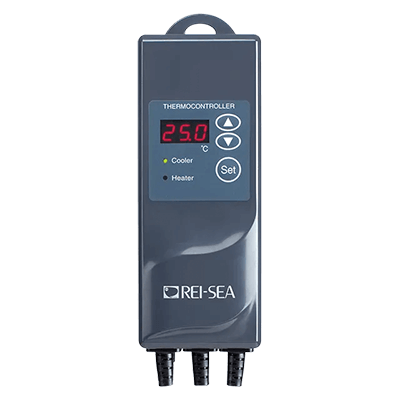What Is a Thermo Controller?

A thermo controller is a device or component that sends an ON/OFF signal to an electric heater or cooler unit to maintain the object’s temperature at a constant level.
It is equipped with a control board, power supply, sensor connection, heater connection, and cooler connection.
From inexpensive devices that only turn ON/OFF near the set temperature, to PID control that detects subtle temperature changes and emits fewer ON control signals and more OFF signals when near the set temperature, and more ON signals and fewer OFF signals when away from the set temperature, maintaining the temperature near the set temperature. There are even expensive ones with built-in programs.
Uses of Thermo Controllers
Inexpensive thermo controllers are often used when the variable temperature range is narrow or the control device is small, such as when controlling the temperature of a small water tank.
Expensive thermo controllers are often used when the variable temperature range is wide, the control equipment is extremely large, or highly accurate temperature maintenance is required. They are incorporated into equipment used for research, experimentation, or testing.
These controllers are essential for environmental control kits available at home improvement stores, analyzers, and incubators used in biology and medicine. They are used to control equipment for petrochemical and food-related facilities.
Principles of Thermo Controllers
The principle and features of the thermocontroller are described below.
The ON/OFF control type thermo-controller converts the signal from the temperature sensor into a temperature and issues an ON signal when it is short of the set value and an OFF signal when it exceeds the set value, thereby maintaining the temperature of the object at a constant level by moving the heater or cooler.
There are two types of thermocontrollers: a digital type that uses a control program and an analog type that moves switches in response to temperature changes.
Expensive, high-precision thermocontrollers are mostly of the PID control type.
PID control (Proportional-Integral-Differential Controller) combines proportional action, which produces an output proportional to the difference between the current temperature and the set temperature, with integral action, which produces an output proportional to the integral value of the temperature difference.
Integral action, which produces an output proportional to the integral of the temperature difference, plus a derivative action, which produces an output proportional to the derivative of the temperature difference, minus a derivative action, which produces an output proportional to the derivative of the temperature difference, pulse width modulation of the output voltage waveform is performed to adjust the heater or cooler output.
Specifically, it is a control that approaches the set temperature as quickly as possible (proportional action), corrects excessive heating and cooling near the set temperature (integral action), and suppresses temperature increase/decrease near the set temperature (derivative action). Differential action can be compared to stepping on the brake.